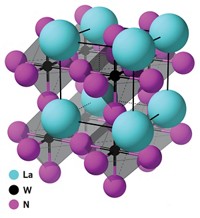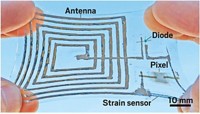Advertisement
Grab your lab coat. Let's get started
Welcome!
Welcome!
Create an account below to get 6 C&EN articles per month, receive newsletters and more - all free.
It seems this is your first time logging in online. Please enter the following information to continue.
As an ACS member you automatically get access to this site. All we need is few more details to create your reading experience.
Not you? Sign in with a different account.
Not you? Sign in with a different account.
ERROR 1
ERROR 1
ERROR 2
ERROR 2
ERROR 2
ERROR 2
ERROR 2
Password and Confirm password must match.
If you have an ACS member number, please enter it here so we can link this account to your membership. (optional)
ERROR 2
ACS values your privacy. By submitting your information, you are gaining access to C&EN and subscribing to our weekly newsletter. We use the information you provide to make your reading experience better, and we will never sell your data to third party members.
2-D Materials
Low-cost perovskite detects X-rays sensitively
Made and processed via wet chemistry, the inexpensive material could improve radiation safety
by Mitch Jacoby
April 10, 2020
| A version of this story appeared in
Volume 98, Issue 14

An inexpensive organic-inorganic combo material that can be prepared and processed via common solution-phase methods can detect X-rays more sensitively than standard costly detector materials (Sci. Adv. 2020, DOI: 10.1126/sciadv.aay0815). The hybrid material, a butylamine–methylamine lead iodide perovskite, could improve safety in X-ray-based medical and security applications by lowering the radiation levels needed to acquire high-resolution images. Commercial X-ray detectors often rely upon high-purity crystals of silicon or other semiconductors grown via energy-intensive methods. Radiation induces electrical charges in the semiconductor, which these devices convert to measurable electrical signals under the influence of high voltage. Researchers including Hsinhan Tsai and Wanyi Nie of Los Alamos National Laboratory and colleagues there and at Argonne National Laboratory knew from their earlier studies that a family of layered perovskites—including the hybrid material—responded sensitively to X-rays and could be used to make devices that work in much the same way. But these materials can be synthesized and made into electronic devices using low-cost wet-chemistry methods. The group made thin-film X-ray detectors with the layered perovskite and compared their performance with that of devices based on silicon and other perovskites. The team found that, in certain conditions, the new device does not require an applied voltage to operate and is about 100 times as sensitive as silicon detectors.





Join the conversation
Contact the reporter
Submit a Letter to the Editor for publication
Engage with us on Twitter